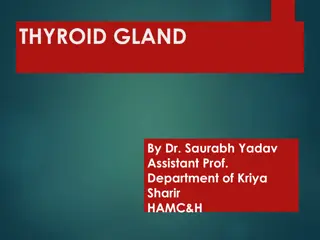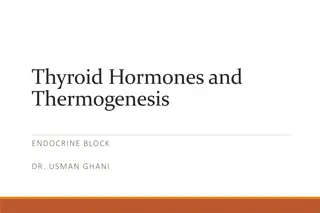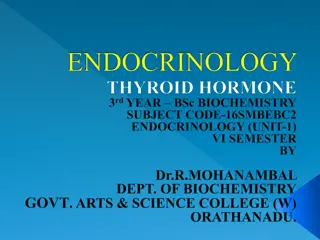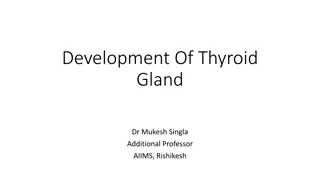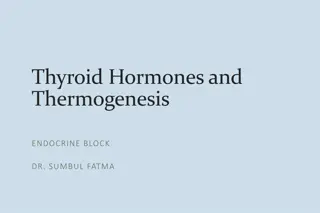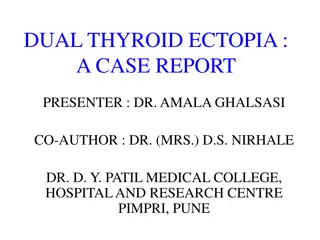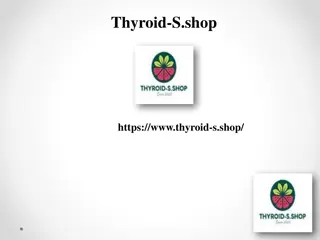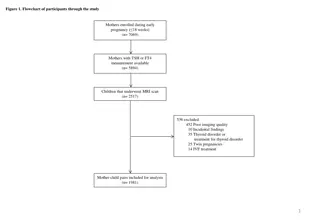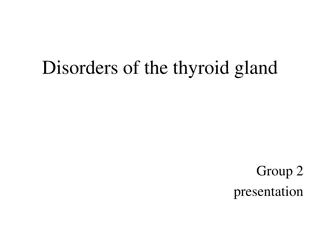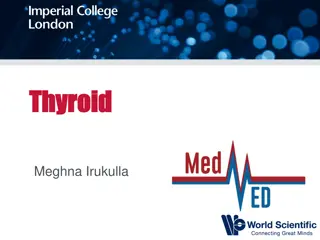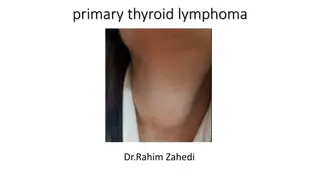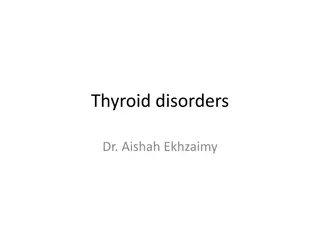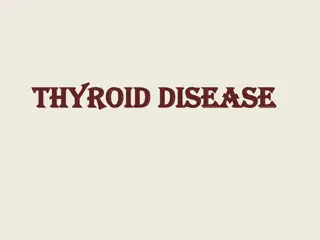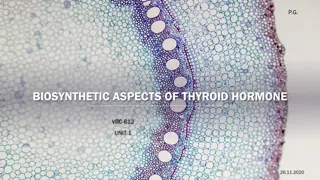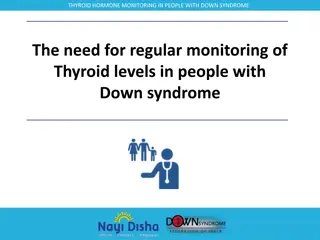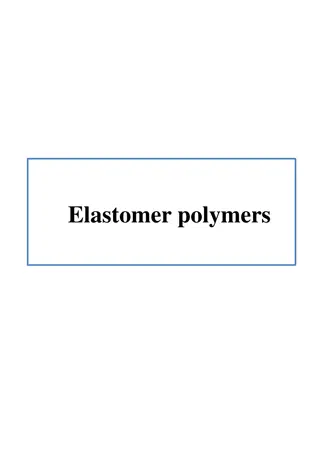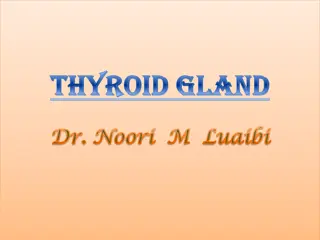
Management of Subclinical Hyperthyroidism According to 2016 ATA Guidelines
Learn about the management of subclinical hyperthyroidism (SH) as recommended by the 2016 American Thyroid Association guidelines. Explore when to treat SH, considerations for different patient groups, and monitoring recommendations for better outcomes.
Download Presentation

Please find below an Image/Link to download the presentation.
The content on the website is provided AS IS for your information and personal use only. It may not be sold, licensed, or shared on other websites without obtaining consent from the author. If you encounter any issues during the download, it is possible that the publisher has removed the file from their server.
You are allowed to download the files provided on this website for personal or commercial use, subject to the condition that they are used lawfully. All files are the property of their respective owners.
The content on the website is provided AS IS for your information and personal use only. It may not be sold, licensed, or shared on other websites without obtaining consent from the author.
E N D
Presentation Transcript
2016 American Thyroid Association 2016 American Thyroid Association Guidelines for Diagnosis and Guidelines for Diagnosis and Management Management of Hyperthyroidism of Hyperthyroidism and other causes of other causes of Thyrotoxicosis part 2 Thyrotoxicosis part 2 and AMERICAN THYROID AMERICAN THYROID ASSOCIATION ASSOCIATION 2016 2016 M.HEIDARPOUR.MD M.HEIDARPOUR.MD
1. How should subclinical hyperthyroidism (SH) be managed? 2. How should hyperthyroidism in pregnancy be managed? 3. How should hyperthyroidism be managed in patients with Graves orbitopathy? 4. How should iodine induced and amiodarone-induced thyrotoxicosis be managed? 5. How should thyrotoxicosis due to destructive thyroiditis be managed? 6. How should other causes of thyrotoxicosis be managed? 7. How should GD be managed in children and adolescents?
How should subclinical hyperthyroidism (SH) be managed? suppress TSH levels (< 0.1 mU/L), or low TSH levels (< 0.4 mU/L)
The natural history of SH is variable , with annualized rates of 0.5 7% progression to overt hyperthyroidism and 5 12% reversion to normal TSH levels. Progression from SH to overt hyperthyroidism appears more likely if the TSH is suppressed (< 0.01 mU/L), rather than low but detectable (0.01 0.4 mU/L) Patients with GD rather than a TMNG as the cause of SH may be more likely to spontaneously remit .
In patients at high risk of complications from SH, TSH and free T4 should be repeated within 2-6 weeks. For all other patients, it is important to document that SH is a persistent problem by repeating the serum TSH at 3-6 months, prior to initiating therapy.
RECOMMENDATION When TSH is persistently <0.1 mU/L, treatment of SH is recommended: 1. in all individuals 65 years of age 2. in patients with cardiac risk factors 3. heart disease 4. osteoporosis 5. in postmenopausal women who are not on estrogens or bisphosphonates; 6. and in individuals with hyperthyroid symptoms Strong recommendation, moderate-quality evidence.
RECOMMENDATION When TSH is persistently < 0.1 mU/L, treatment of SH should be considered in asymptomatic individuals < 65 years of age without the risk factors . Weak recommendation, moderate-quality evidence.
RECOMMENDATION When TSH is persistently below the lower limit of normal but 0.1 mU/L, treatment of SH should be considered: 1. in individuals 65 years of age 2. in patients with cardiac disease 3. Osteoporosis 4. symptoms of hyperthyroidism Weak recommendation, moderate-quality evidence
RECOMMENDATION When TSH is persistently below the lower limit of normal but 0.1 mU/L, asymptomatic patients under age 65 without cardiac disease or osteoporosis can be observed without further investigation of the etiology of the subnormal TSH or treatment. Weak recommendation, low-quality evidence.
However, younger subjects should be monitored at regular 6-12 month intervals, and treatment should be considered if the TSH persistently decreases to < 0.1 mU/L. In patients with symptoms of hyperthyroidism, a trial of beta adrenergic blockers may be useful to determine whether symptomatic therapy might suffice.
RECOMMENDATION If SH is to be treated, the treatment should be based on the etiology of the thyroid dysfunction and follow the same principles as outlined for the treatment of overt hyperthyroidism. Strong recommendation, low-quality evidence.
RAI is appropriate for most patients, especially in older patients when TMNG is a frequent cause of SH. There are no data to inform whether elderly patients with SH would benefit from pretreatment with ATDs to normalize thyroid function before RAI therapy.
A course of ATD therapy is a reasonable alternative to RAI in patients with GD and SH, especially in younger patients, since remission rates are highest in persons with mild disease. Some patients with SH due to GD may remit spontaneously without therapy , so that continued observation without therapy is reasonable for younger patients with SH due to GD.
How should hyperthyroidism in pregnancy be managed?
pregnancy pregnancy- -related variations in thyroid function tests related variations in thyroid function tests Serum TSH levels: o May be below the non-pregnant reference range in the first half of a normal-term pregnancy, and especially so in gestational weeks 9-13, where a subset of pregnant women may develop a suppressed serum TSH . o The decrease in TSH in early pregnancy is the result of stimulation of the normal thyroid by high levels of serum hCG, and occasionally the biochemical findings developing may correspond to overt thyrotoxicosis (gestational hyperthyroidism ). oHowever, low serum TSH levels with normal free T4 (or total T4) in early pregnancy do not indicate disease in need of therapy. o During the second half of pregnancy, the lower limit of normal for TSH in the non- pregnant population can be used.
Free T4 and T3 : oAaround week 10 of pregnancy may be slightly higher (5 10%) than non-pregnancy values, corresponding to the period of high serum hCG and low serum TSH. o From normal or slightly elevated levels, a gradual decrease occurs during pregnancy, and late third trimester reference values are 10 30% below non-pregnancy values.
Total T4 and T3: oIncrease in parallel in early pregnancy, primarily due to increases in TBG. In one longitudinal study, the increase in T4 and T3 reference ranges were observed to occur at a rate of 5% of non-pregnant values per week over the 10 week period of gestation weeks 7-16 . o After this 50% increase, total T4 and T3 values remain stable with reference range limits 1.5 times above nonpregnancy ranges over the remaining weeks of pregnancy.
RECOMMENDATION The diagnosis of hyperthyroidism in pregnancy should be made using: oserum TSH values and oeither total T4 and T3 with total T4 and T3 reference ranges increasing to 1.5 times above the nonpregnant range by the 2nd and 3rd trimester oor free T4 and total T3 estimations with trimester-specific normal reference ranges. Strong recommendation, low-quality evidence.
Excluding patients with TSH suppression or gestational thyrotoxicosis during the first trimester, GD is the most common cause of hyperthyroidism during pregnancy ; nodular thyroid disease is less common. Hyperthyroidism caused by a hCG-producing molar pregnancy or a choriocarcinoma presents with a diffuse hyperactive thyroid similar to GD, but without eye signs and without TRAb being detectable in serum. In these patients, serum hCG will be higher than expected.
RECOMMENDATION Transient hCG-mediated TSH suppression in early pregnancy should not be treated with antithyroid drug therapy. Strong recommendation, low-quality evidence.
Gestational hyperthyroidism is a generally asymptomatic, mild and self-limiting biochemical hyperthyroidism that may be observed in the first trimester of normal pregnancy. The disorder lacks the characteristics of GD , and is caused by the high serum hCG of early pregnancy . It is not associated with adverse pregnancy outcomes. More severe degrees of gestational hyperthyroidism are associated with hyperemesis; affected women may develop biochemically overt hyperthyroidism and clinical symptoms and signs of hyperthyroidism.
There is no evidence that treatment of gestational hyperthyroidism with ATDs is beneficial . In these patients, physical examination and repeat thyroid function tests at intervals of 3 4weeks is recommended. In the case of very symptomatic disease, a trial of beta-blocker therapy (propranolol or metroprolol, but not atenolol for this transient disorder may be considered.
RECOMMENDATION ATD therapy should be used for overt hyperthyroidism due to GD during pregnancy. PTU should be used when ATD therapy is given during the first trimester. MMI should be used when ATD therapy is started after the first trimester. Strong recommendation, low-quality evidence.
PTU generally has been preferred in pregnancy because of concerns about well documented teratogenicity associated with MMI. Defects that may be observed in 2-4 % of exposed children have included aplasia cutis, choanal atresia, esophageal and other types of gut atresias, abdominal wall abnormalities including omphalocale, eye, heart, and urinary tract malformations. Recently, an increase in the rate of birth defects (2.3 % above the background rate) was also observed after PTU exposure in early pregnancy , but these defects tended to be less severe than with MMI and included preauricular sinuses and cysts and urinary tract abnormalities.
In a large group of children selected because they had major birth defects and had been exposed to some type of medication in early pregnancy, children exposed to PTU had a significantly higher frequency of situs inversus and cardiac outflow abnormalities than children exposed to other drugs. The period of highest risk for birth defects from ATDs is gestational weeks 6-10.
RECOMMENDATION In women who develop hyperthyroidism during their reproductive age range, the possibility and timing of future pregnancy should be discussed. Because of the risks of the hyperthyroid state on pregnancy and fetal outcome, we suggest that women should postpone pregnancy until they have become euthyroid with therapy. Strong recommendation, low-quality evidence.
RECOMMENDATION We suggest that women with hyperthyroidism caused by GD that require high doses of ATDs to achieve euthyroidism should be considered for definitive therapy before they become pregnant. Weak recommendation, low-quality evidence.
Thyroidectomy is often followed by a decrease or disappearance of TRAb from circulation, whereas RAI is often followed by a transient increase in TRAb. This is a potential argument in favor of surgical thyroidectomy in women with high TRAb titers that may become pregnant within the years to come, especially those planning therapy within the next year. However, the importance of this difference in autoimmune activity for pregnancy outcome has not been studied, and it should be weighed against the other benefits and harms of surgery and RAI therapy.
RECOMMENDATION Women with hyperthyroidism caused by GD who are well controlled on MMI and desire pregnancy have several options: a) Patients could consider definitive therapy before they become pregnant. b) Patients could switch to PTU before trying to conceive. c) Patients could switch to PTU as soon as pregnancy is diagnosed. d) Appropriately selected patients could withdraw from ATD therapy as soon as pregnancy is diagnosed. If ATD therapy is withdrawn, thyroid function should be assessed weekly throughout the first trimester, then monthly. Weak recommendation, low-quality evidence.
A.Definitive therapy before becoming pregnant It has the advantage of allowing the patient to become pregnant free of worry from the adverse fetal effects of ATDs. The disadvantage is that the patient will require levothyroxine therapy while pregnant and lifelong, and will be exposed to either the potential complications of RAI, including worsening or induction of Graves orbitopathy, or the potential for undesirable surgical outcomes.
B. Switching from MMI to PTU before pregnancy. Switching from MMI to PTU before conception would eliminate the risk from early pregnancy exposure to MMI in women where pregnancy is not recognized within the first few weeks after conception. Switching to PTU before conception may be preferred in younger women with regular menses who are expected to be able to conceive within 1 to 3 months.
C. Switching from MMI to PTU after conception. Switching to PTU as soon as pregnancy is diagnosed may be preferred in older women and women who have conditions that may be associated with delayed conception. This strategy may prevent prolonged use of PTU prior to conception but has the risk of fetal exposure to MMI if the diagnosis of pregnancy is delayed.
D. Withdrawing ATD treatment after conception. Women with a stable euthyroid state on 5-10 mg MMI per day achieved within a few months, and a falling TRAb level are likely candidates to withdraw from ATD therapy in early pregnancy. Based on the latter studies, the risk of relapse of hyperthyroidism within a two month interval after ATD withdrawal in TRAb negative, non-smoking patients who have already been treated for 12-24 months is <10 % . Frequent testing of thyroid function will allow early detection of such relapse and initiation of therapy with PTU (or MMI if relapse occurs in the second trimester) to keep the mother euthyroid.
RECOMMENDATION We suggest that women who are treated with ATD and who may potentially become pregnant should be instructed to perform a pregnancy test within the first days after a missed or unusually light menstrual period. Weak recommendation, low-quality evidence.
The period of major risk of birth defects caused by intake of medication in pregnancy is gestational weeks 6-10 , Thus, withdrawal of ATD therapy before week five of pregnancy may theoretically prevent birth defects caused by ATD exposure.
RECOMMENDATION We suggest that a woman who tests positive for pregnancy contact the physician responsible for the ATD therapywithin 24 hours to discuss future treatment options. Weak recommendation, low-quality evidence.
RECOMMENDATION We suggest that the physician evaluate whether ATD withdrawal in the first trimester of pregnancy is likely to cause relapse of hyperthyroidism or not. Evaluation should be based on patient records, especially the severity of GD at time of diagnosis and current disease activity, duration of ATD therapy, current ATD dose requirement, and results of recent thyroid function and TRAb testing. If risk of relapse is considered low, therapy can be withdrawn, and followed by weekly thyroid function testing during the 1st trimester. Weak recommendation, low-quality evidence.
RECOMMENDATION We suggest that women in early pregnancy who have a high risk of recurrent or worsening hyperthyroidism if ATD is withdrawn be shifted from MMI to PTU immediately after diagnosing pregnancy. Weak recommendation, low-quality evidence. (A dosage ratio of MMI to PTU of 1:20 is recommended when changing from one drug to another.)
RECOMMENDATION Women taking PTU during the 1st trimester of pregnancy may be switched to MMI at the beginning of the 2nd trimester, or they may continue PTU therapy for the remaining part of pregnancy if ATD is needed. No Recommendation, insufficient evidence to assess benefits and risks.
RECOMMENDATION GD during pregnancy should be treated with the lowest possible dose of ATD needed to keep the mother s thyroid hormone levels at or slightly above the reference range for total T4 and T3 values in pregnancy (1.5 times above non-pregnant reference ranges in the 2nd and 3rd trimester), and the TSH below the reference range for pregnancy. Similarly, free T4 levels should be kept at or slightly above the upper limit of the pregnancy trimester reference range for the assay. Thyroid function should be assessed at least monthly, and the ATD dose adjusted, as required. Strong recommendation, lowquality evidence.
Even if the mother is euthyroid during ATD therapy, there is a risk of inducing fetal hypothyroidism and goiter during the second and third trimesters when the fetal thyroid has begun to function . Thus, the dose of ATD should be kept as low as possible. Free T4 is the parameter that has been most closely correlated with good fetal outcome. Serum TSH may still be suppressed in these patients and should not be used as the sole guide in treatment, although normalization of maternal TSH during ATD therapy may indicate a need to reduce the dose of ATD.
Maternal thyroid function should be monitored frequently and non-invasive assessment of fetal thyroid function (e.g. fetal heart rate, bone maturity, and fetal goiter on ultrasound), and ATD therapy balanced to keep acceptable thyroid function in both the mother and the fetus .
RECOMMENDATION Pregnancy is a relative contraindication to thyroidectomy and should only be used when medical management has been unsuccessful or ATDs cannot be used. Strong recommendation, low-quality evidence .
RECOMMENDATION When thyroidectomy is necessary for the treatment of hyperthyroidism during pregnancy, the surgery should be performed if possible during the second trimester. Strong recommendation, low-quality evidence.

